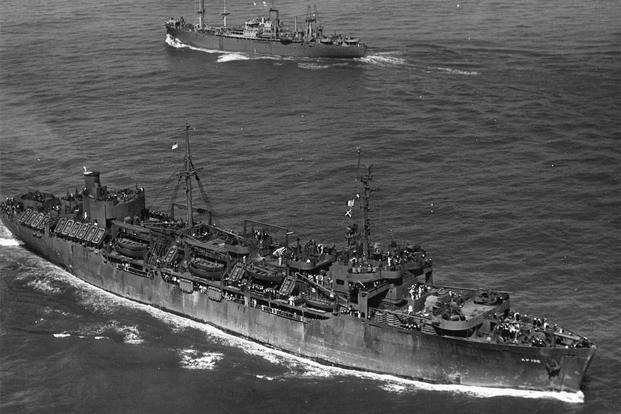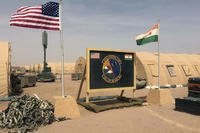My name is James Hollis Bearden. I am an American citizen. I was born October 3, 1922 in Shelbyville, Tennessee. I moved to Cairo, Georgia in 1938 and lived with an uncle, so I could play football for Cairo High School. I was drafted in May 1943. I decided to join the Navy. I had my boot camp training at Bainbridge Naval Station in Bainbridge, Maryland. After a short leave, I went back to Bainbridge and attended Boatswain School. I received further training in New Orleans, Louisiana. From New Orleans, I boarded the ship General G.O. Squier. We docked in the English Channel.
Here we picked up Landing Craft Tank ships. We trained for amphibious landings. On June 1, 1944, our LCT was loaded with 180 tons of ammunition. Then on June 4, 300 combat soldiers entered our LCT. The soldiers were given invasion money. One asked me, "What kind of money is this?" I told them they'd find out the next morning.
On June 5, we started across the Channel for the Normandy invasion. Because of the weather, we were turned back. On June 6, we started again. There were thousands of ships and airplanes. About 3:00 A.M. the planes flew over. First they dropped bombs and next came the paratroopers. About two or three miles out from the beach, destroyers and cruisers sprayed the beachheads with gunfire. We were in the first wave to hit Normandy.
We hit the beaches at high tide. This was at 5:30 A.M. on June 6, 1944. After dropping the anchors we set down the ramp to let the soldiers off. We couldn't leave until high tide so we dug fox holes, removed the wounded, and waited for the trucks to unload our ship.
The crew aboard the LCT was the captain, Lieutenant John D. Allen from Youngstown, Ohio, boatswain (myself), two electricians, two machinist mates, three or four gunners mates, one signal man, and the cooks. One name I remember was Thaddeus Kadinsky from Pittsburg, Pennsylvania. Three boys had the last name of Green and were from Texas.
After the tide came back in, we pulled our ship off the beach and went back to the Merchant Marine ship to reload. Some of the landing crafts would hit sandbars. Thinking they were on the beach, they hurriedly jumped out. Many sailors were drowned. On the third wave, we carried in a ship that General George S. Patton was on.
The enemy had pillboxes up in the cliff. They were loaded with guns, supplies, and ammunition. There were tunnels running to the pillboxes. The only way our soldiers could get to the problem was to send up two tanks at one time. The first tank would be hit, but the next one would get up there and shoot the enemy before they could reload.
After the beachhead was secured, we went through these tunnels. One soldier had his left arm shot off above the elbow. Still, he helped us load the wounded. We carried the wounded out to the hospital ship. A bulldozer came and dug trenches and buried the dead.
A few months later, a few of us sailors decided we wanted to go see Paris. We stole a jeep off the ship. It was in a box and we had to assemble it. Since Navy personnel was not allowed in Paris, we borrowed some of the soldier's uniforms, dressed in them, and took off for Paris. We were on the outskirts of Paris when we were stopped and asked for our identification.
Needless to say, we never saw Paris. When the MP's saw our Navy ID's, we were placed in confinement until our ship's captain could be notified. We were there for five days before returning to the ship. I stayed in the Navy til the war was over. The only time I came home during these three years was after I finished boot camp.














